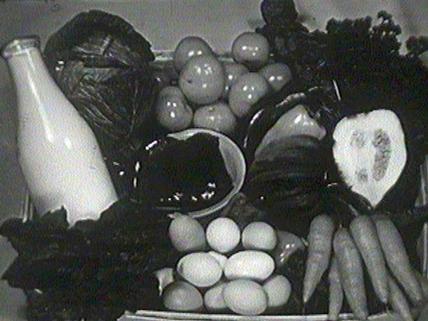Vitamins A, B1, C and D
|
Canada, 1943 (documentary / children's, 15 minutes, colour, English)
|
|
Also known as
"Vitamines A, B1, C et D"
|

|
| Image: © National Film Board of Canada |
Film Description:
"A four-part survey of the quantities and qualities of food needed to counteract wartime food shortages. It emphasizes the importance of vitamins A, B, C and D in well-balanced meals for children and mothers."
-- National Film Board of Canada
(source)
|
| Film Credits (partial): |
| Film Editing: |
Gudrun Parker |
| Production Company: |
National Film Board of Canada / Office national du film du Canada |
(sources)
Quotes about Vitamins A, B1, C and D
"At the time of the wartime concern with nutrition, Gudrun [Bjerring] was asked to make a series of films for very young children. This was her first real assignment, and though the films were very short, just four minutes each, she had to bone up on vitamins from A to—well, E. The nutritionists gave her the facts, but the problem remained: how to persuade the children that they should like what was good for them? It's an old question; and it was John Grierson who suggested using rhymes to carry the message of the script. One went: 'A is for Airmen, whose vision is keen; their diet has plenty of carrots and cream'. Perhaps the rhyme isn't very good, but the reactions of the youngsters were excellent, though Gudrun isn't convinced they all ate up their carrots as a result."
-- Elspeth Chisholm
(source)
"The day [Gudrun Parker] arrived to work at the Film Board, on March 1, 1942, she said that she didn't get to sit down until 10:00 p.m. As an editing assistant for Raymond Spottiswood, she noted that sixteen-hour days, at $25.00 per week, were not uncommon. Gudrun Parker related the amusing story of how she came to make her first films at the Board. While attending an NFB party she went up to [John] Grierson and told him, 'I would like to make some films.' His reply was, '... then go get some money and make them!' So in the next few days she visited the Health and Welfare Department of the federal government where she discussed the need for films which would educate the public on vitamins. The Health and Welfare official, whom she says she'll never forget because he served her hot tomato juice while they spoke, was enthusiastic about her idea and agreed to fund the films. Gudrun enlisted Judith Crawley to do the camerawork. Gudrun directed and edited, and soon she had the rough cuts of three short films on vitamins A, B and C, respectively. Two months after the NFB party she saw Grierson in the corridor. He had been out of town and asked her if she had given any more thought to making a film. Much to his amazement she told him that she had three films which were in fact almost complete and wanted him to see them."
-- Mary Teresa Nash
(source)
"[Gudrun Bjerring] Parker had worked as a journalist with the Winnipeg Free Press before coming to the NFB in March 1942. Hired as an assistant editor, Parker quickly showed a desire to make her own films. [John] Grierson told her to go find some money. She met with staff from Health and Welfare Canada (known today as Health Canada), and submitted a proposal for a three-film project on the importance of vitamins for the nutrition of women and children. After going back and forth several times, staff at the ministry agreed to fund the project. Parker hired Judith Crawley as cinematographer, and directed three films that were eventually released under one title: Vitamins A, B1, C and D (1943)."
-- Marc St-Pierre
(source)
Quote about Vitamins A, B1, C and D [in French]
"Gudrun Bjerring Parker[...] travaille comme journaliste au Winnipeg Free Press avant d'être embauchée à l'ONF en mars 1942 comme assistante-monteuse. Très vite, elle manifeste le désir de réaliser des films. Elle en fait part à [John] Grierson, qui lui suggère d'abord de trouver de l'argent. Elle rencontre les responsables de Santé et bien-être social Canada, aujourd'hui Santé Canada, et leur soumet un projet de trois films sur l'importance des vitamines dans l'alimentation des femmes et de leurs enfants. Après plusieurs échanges, les responsables du Ministère acceptent de subventionner le projet. Elle engage aussitôt Judith Crawley à la caméra et tourne trois courts films qui en deviendront un seul, Vitamins A, B1, C and D (1943)."
-- Marc St-Pierre
(source)
Web Sites about Vitamins A, B1, C and D


